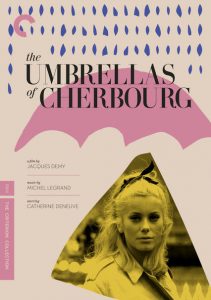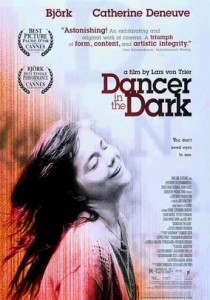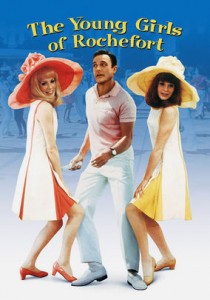The Umbrellas of Cherbourg-1964
Director Jacques Demy
Starring Catherine Deneuve, Nino Castelnuovo
Scott’s Review #911
Reviewed June 17, 2019
Grade: A
The Umbrellas of Cherbourg (1964), translated in French as Les Parapluies de Cherbourg, is a daring film. It is unique in that all dialogue is sung recitatively, like an opera or a stage musical.
But wait, there’s more.
The film has colorful and dazzling set designs that enrich the entire experience amid the lovely French culture and atmosphere. Interspersing a melody, the result is a stoic treasure.
The film received an Oscar nomination for Best Foreign Language Film and several other nominations.
The film is divided into three parts and progresses chronologically over six years. Part One is The Departure; Part Two is The Absence and Part Three is The Return, each representing a meaningful part of the story.
Madame Emery (Anne Vernon) and her sixteen-year-old daughter Genevieve (Deneuve) own a struggling umbrella boutique in Cherbourg, France. Genevieve falls in love with Guy (Castelnuovo), a local mechanic, and they have sex the night before he is drafted to war, resulting in an unexpected pregnancy.
Madame Emery and Genevieve must decide what options are best when she is courted by wealthy jeweler Roland (Marc Michel), unaware of her pregnancy. Genevieve and Guy continue to write letters to each other as she softens towards Roland and makes a decision.
An injured Guy returns from the war, and events kick into high gear as the love birds face an uncertain future amid surrounding barriers to their happiness.
To embrace the flavor and pacing of the film takes a few minutes of patience- like some viewers becoming accustomed to sub-titles in general, which the film also possesses, the singing is initially quite jarring but before long is to be embraced and appreciated for its unique nature.
To stress the point, the film is not a standard musical. Songs are mixed in with conventional dialogue, and each line is sung.
With this role, Deneuve gained wider recognition beyond a French audience already familiar with her work. She shines brightly in the lead role and never looks lovelier. The young lady, hardly appearing to be just sixteen (in truth, she was twenty-one), carries the film with a chic and sophisticated style, ideally in tune with the 1960s.
Her magnificent grace and elegance make her the primary reason to tune in. She sings her lines flawlessly and with unforced precision.
The story is unequivocally a basic one of a girl meets a boy, the boy is drafted into the army, the girl becomes pregnant, the girl meets another suitor, and the boy returns home as conflict arises.
The magic is what director Jacques Demy does with the piece.
Everyday life is presented in situational scenes, adding substance and commonalities. Genevieve and Guy are in love and face external and internal obstacles. At the same time, Madeleine (Ellen Farner), a quiet young woman who looks after Guy’s aunt, is secretly in love with Guy, as she adds a secret weapon to the film.
The audience cares for the characters, especially Genevieve and Guy, but the supporting characters add a robust quality worthy of mention.
Anne Vernon is pivotal as Madame Emery. She is stylish and lavish, concerned for her daughter’s well-being, and slyly sees opportunities to save her boutique. Guy’s sickly Aunt Elise provides security and love to those who heed her advice.
Actress Mireille Perrey plays her.
The vivid colors and sets make The Umbrellas of Cherbourg challenging to forget. Stark and florescent painted pinks, greens, and blues, mainly on the walls, provide zest and flavor, a grand style all its own.
The bright, crisp designs evoke a lavish Hollywood musical with a cultured French twist. The result is perfect, and one can easily immerse themselves in the singing and the artistry.
The recurring main song “I Will Wait for You” (the central theme, also known as “Devant le garage”) is delicious and emotional as it appears in many poignant scenes.
Those seeking a charismatic and distinctive experience with nuances and a hint of experimentation will undoubtedly enjoy this fruity and tasty treat.
With a French atmosphere for miles, the film encompasses all that is good and cultured about French cinema.
The Umbrellas of Cherbourg (1964) will entertain and unabashedly knock your socks off with something grand and sizzling flavor.
Oscar Nominations: Best Foreign Language Film, Best Story and Screenplay Written Directly for the Screen, Best Song-“I Will Wait for You,” Best Music Score-Substantially Original, Best Scoring of Music-Adaptation or Treatment





